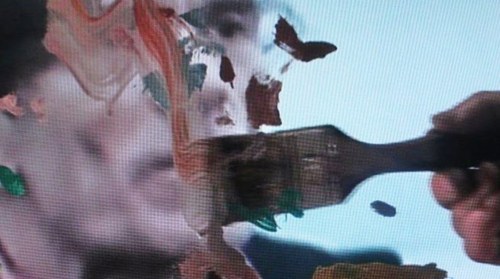translation of these notes on Gesichtsphilosophie

The interface not only crosses space: to look at means to empathize, to look at a face means to conceive feelings. Not towards the immediate. The modus is not dissection, but empathic association of constellations.
Appearance is partly played and partly unconscious visual expression of feelings. Language therefore is the fitting model, not the laid open heart, face recognition, lie detector. The communication without masks would be the abolishment of art, which in other concepts would be sublated in a play of miens. Otherwise hope would be scattered.
Search for the small – if even existing – fissure between the played facial expression in accordance with types, and that which is not possible to typify in the played mien, the true play, which even can survive in the image making process, and which has to resist twice, the industrial style and the identification constraint of the normed role models. It seems to get more abstract when the whole body is speaking, faces are too trained.
The face is caught in the crisis of history, aim to do Good Gesichtsphilosophy (a play of words, remixing the word Geschichtsphilosophie – philosophy of history – and making a philosophy of the history of the face), not just philosophize around on the face. It is not about truth, immediateness, the total mediation of all with all, the total transparancy, the knowledge about the inner and outer life of all fellows, it is about less pain (until the last pain of being human, the endlessly free human) and about another quality of being, it is about the conditions of the faces, the faces that are subject to history.
The mien presents itself as a played and conceived as played sign, in which, more obvious than it is with the words, a open space is kept in mind. It is basically a challenge to pick up this topic in art, for you have to consciously construct an open process, which goes against the grain for parts of contemporary art and its mentality of aiming at effect, be it highpass at the mixing console, color field signals, battles of symbols, cartoon figures or hard words poetry. Also not meant is arbitrariness, unpolitical, meaningless, endlessly open snapping and blotting.
Some work on this through stencils. As abstraction of the facial expression, to be sensed like seen through cloth. On the contrary: Mona Lisa, this incomprehensible and successful cultural product.
Play of miens: an utopist idea, in which the people freely play with a central means of communication, the playful system of signs, the face. Just that there is no historic break, like today only lookism, as a forced adaption of superficial norms, and tomorrow the free play of miens, but in the option to be quiet and letting the face speak, lies one of so many possibilities of communication. To be not understood, but to ask for empathy. This story needs models.
We already pay with likes, maybe we soon pay with a smile, the city becomes the catwalk of those who are superflous, the total integration of culture industry reconciles itself with bio politics. The class of the face performers and the laid open miens of the governed, who cannot control themselves. We have to recognize our tender mien play.


















